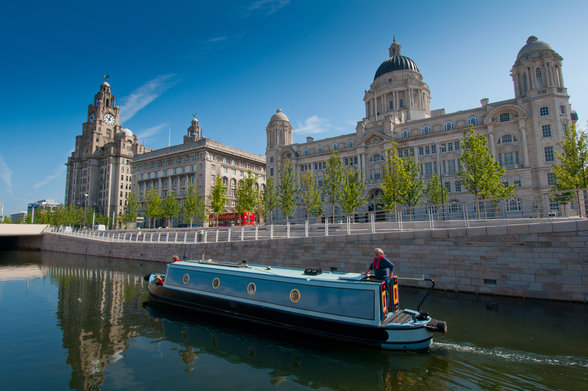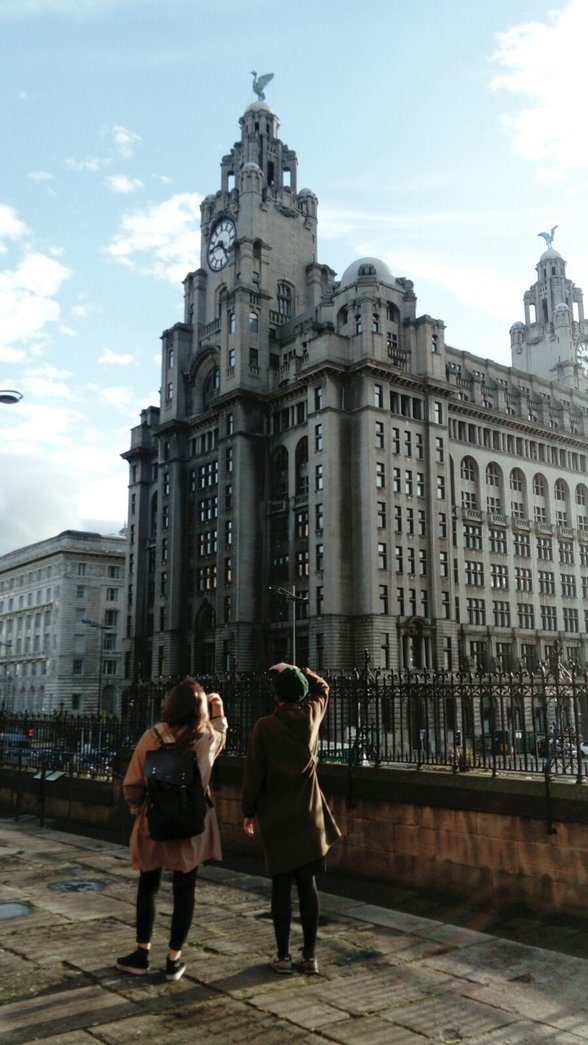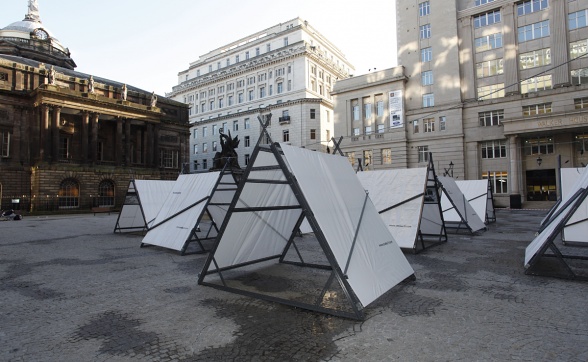Make Yourself at Home: 10 facts about Liverpool artists discovered on their first visit
Posted on 17 November 2017 by Liverpool Biennial
Liverpool waterfront. Image courtesy FACT Video Productions / Carl Davies
How much do you know about the history of our wonderful city? We joined some of the Biennial 2018 artists on their architectural tour of Liverpool and discovered a whole new side to the buildings and history that we thought we knew so well. Here’s what you should know before you visit Liverpool Biennial 2018: Beautiful world, where are you?
1. The city’s name derives from...
... the word ‘liver’, which is a type of seaweed, while ‘pool’ means estuary.
2. The River Mersey rises and falls...
... by an incredible 30 metres with each tide which impacts the movement of the ships and ferries that sail across it every day, including our iconic Dazzle Ferry commission by Sir Peter Blake.

Sir Peter Blake, Everybody Razzle Dazzle, 2015. Photo courtesy Mersey Ferries
3. Not only is the Port of Liverpool building one of Liverpool’s Three Graces...
... its design was inspired by an unused blueprint for Liverpool's Anglican Cathedral. The river-facing main entrance is flanked by two three-metre-high stone statues of women representing 'Commerce' and 'Industry'.

Liver Building and Port of Liverpool Building. Image courtesy Visit England
4. The Strand’s prominent ventilation tower serves what was once the longest underwater tunnel...
... in the world! Its distinctive design comes from local architect Herbert G. Rowse, who had spent time working in America and was influenced by the buildings he found there. Look closely and you might spot some carved Buddha-like figures on either side of the building, representing day and night since the tunnel remains open 24-hours a day. Keep your eyes closer to the ground, and you’ll see Betty Woodman’s Liverpool Fountain from Biennial 2016.

Right: Betty Woodman, Liverpool Fountain, 2016. Installation view at St. George's Dock Ventilation Tower Plaza. Photo by Jerry Hardman-Jones. Left: Buddha-like figures. Photo: Sara Jaspan.
5. Liverpool: the New York of England?
First built in 1911, the famous Liver Building was considered a skyscraper and was one of Britain’s first.

Artist Holly Hendry and Biennial curator Sinead McCarthy explore the city
6. The Grade I-listed Oriel Chambers were originally used as offices...
... where samples of products and supplies arriving from overseas were sent to be examined. Due to the lack of electrical lighting, its eye-catching windows were designed to let in as much natural light as possible. When first built, critics hated it, but now it is one of the city’s most loved buildings.

Oriel Chambers
7. Before there were telephones, the merchants of industrial Liverpool would congregate in Exchange Flags to do...
... business. Most of the cotton trade that fed the industrial revolution throughout the North happened here and, according to legend, the stone flagged-floor was always covered with a layer of cotton wool; not unlike the way that Biennial 2012 artist Hsieh Ying-Chun filled the Square with tents!

Hsieh Ying-Chun, Re-Live, 2012. Photograph by Jerry Hardman-Jones
8. While Exchange Flags was the nerve centre for merchants’ activity...
... nearby Castle Street was historically the heart of financial services in Liverpool.

2018 artists visit Exchange Flags
9. From the 1890s, an overhead railway...
... serving the dock estates used to run the length of the 7-mile dock network until it sadly fell into disrepair, eventually closing in 1956.
10. The Titanic Monument found at the Pier Head was erected as a monument...
... to the engine room staff of the Titanic – considered to be one of the first civic monuments to 'working class heroes', and reflecting Liverpool’s strong and personal connection with industry.
Liverpool Biennial 2018: Beautiful world, where are you? runs between 14 July – 28 October.See the full list of confirmed artists and find out more here.
Catch a glimpse below of our artists’ journey through Liverpool, as they explored everywhere from the historic Albert Dock to some Biennial 2018 venues where their work will be shown.
Liverpool Biennial
55 New Bird Street
Liverpool L1 0BW
- T +44 (0)151 709 7444
- info@biennial.com
Liverpool Biennial is funded by
Founding Supporter
James Moores
